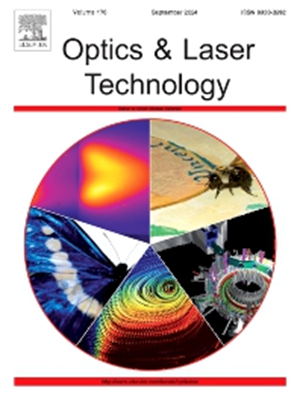Accelerating image reconstruction of asynchronous optofluidic time-stretch imaging flow cytometry
IF 4.6
2区 物理与天体物理
Q1 OPTICS
引用次数: 0
Abstract
Imaging flow cytometry is a powerful tool for profiling cell samples based on cell morphology. Optofluidic time-stretch imaging flow cytometry enhances this process with high-throughput and high-precision cell analysis capabilities, essential for fields such as cell biology and clinical medicine. The processing platform integrated with ADC and FPGA is crucial for achieving real-time acquisition and analysis of the cell image data. Synchronous sampling simplifies the image reconstruction process and provides good image quality but increases overall system complexity. Conversely, asynchronous sampling can significantly simplify the system structure and enhance flexibility, but it requires a complex algorithm to compensate for deviations between the sampling clock and the pulse repetition frequency, affecting the real-time data processing performance. In this study, we propose a calibration algorithm to accurately reconstruct the optical time-stretch imaging (OTS) image of asynchronous OTS systems. By implementing a portion of the proposed algorithm on the FPGA during the front-end data acquisition process, we achieve up to 26.82 times acceleration in image reconstruction. Furthermore, we leverage thread acceleration to enable asynchronous OTS systems to achieve a frame rate of up to 1066.11 frames per second (FPS), representing the highest reported rate for image reconstruction in asynchronous OTS imaging. This research provides valuable insights into optimizing OTS imaging systems for real-time applications, facilitating the commercialization of optofluidic time-stretch imaging flow cytometry and widespread adoption in clinical applications.
求助全文
约1分钟内获得全文
求助全文
来源期刊
CiteScore
8.50
自引率
10.00%
发文量
1060
审稿时长
3.4 months
期刊介绍:
Optics & Laser Technology aims to provide a vehicle for the publication of a broad range of high quality research and review papers in those fields of scientific and engineering research appertaining to the development and application of the technology of optics and lasers. Papers describing original work in these areas are submitted to rigorous refereeing prior to acceptance for publication.
The scope of Optics & Laser Technology encompasses, but is not restricted to, the following areas:
•development in all types of lasers
•developments in optoelectronic devices and photonics
•developments in new photonics and optical concepts
•developments in conventional optics, optical instruments and components
•techniques of optical metrology, including interferometry and optical fibre sensors
•LIDAR and other non-contact optical measurement techniques, including optical methods in heat and fluid flow
•applications of lasers to materials processing, optical NDT display (including holography) and optical communication
•research and development in the field of laser safety including studies of hazards resulting from the applications of lasers (laser safety, hazards of laser fume)
•developments in optical computing and optical information processing
•developments in new optical materials
•developments in new optical characterization methods and techniques
•developments in quantum optics
•developments in light assisted micro and nanofabrication methods and techniques
•developments in nanophotonics and biophotonics
•developments in imaging processing and systems

 求助内容:
求助内容: 应助结果提醒方式:
应助结果提醒方式:


